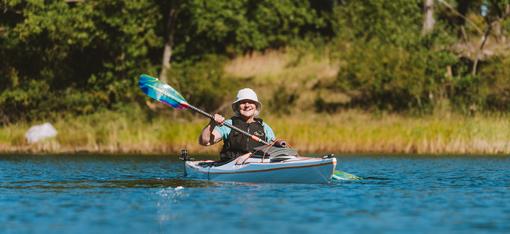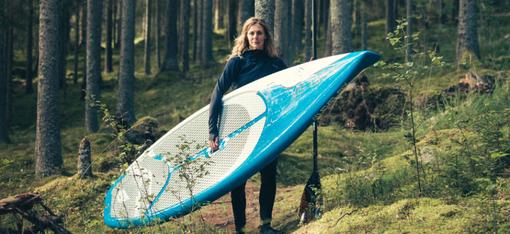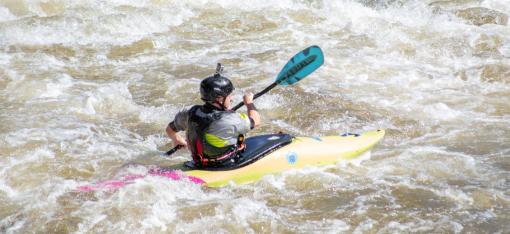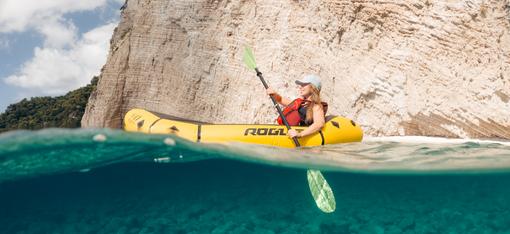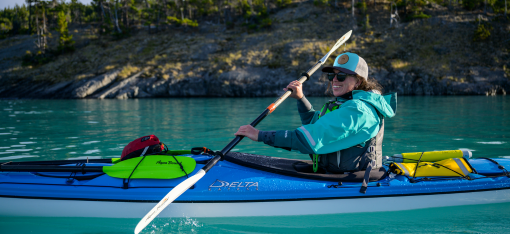Are You Making These 10 Rookie Paddle Boarding Mistakes?
So you’ve decided to dive into the world of SUP. You’ve got your new SUP board and Aqua-bound paddle and are ready to hit the water…or are you?

(Photo courtesy of Scottie Peterson)
It’s true—one of the allures of stand-up paddleboarding (SUP) is that it’s relatively easy to learn.
But there are still a few things you’ll want to have squared away before you get on the water. While it’s easy to just wing it, we want to be sure you get the most out of paddle boarding you can, and that you stay safe while you do it.
#1. You Don’t Wear a Life Jacket
This one isn’t just a rookie mistake. Many in the SUP world neglect this #1 safety requirement. In a way, it’s understandable as paddle boarding was born from the surfing culture, and surfers use their board as their PFD.
Most states consider a paddle board to be a boat, though, and therefore require a PFD to be at least on board with you, if not on your person. And children are usually required to wear theirs. Be sure and check the boating rules where you live.
If you don’t want to wear a bulky PFD like the one in the photo above, consider an inflatable model. These are much more streamlined, although quite a bit more costly.
Here’s a closer look at life jackets and paddle boarding.
#2. You Hold the Paddle Backwards
All of Aqua-Bound’s SUP paddles have a 10º bend in the shaft. Most new paddlers assume the blade should bend towards you as you paddle. While it may seem intuitive, it’s actually backward.
The blade should angle away from you for an effortless and efficient stroke. Think about how much less water weight you pull each time when the blade slips cleanly out of the water! When you hold the paddle backwards, you’ll tire much faster.
A sure sign of a rookie SUPer is holding that paddle the wrong way.

(Photo courtesy of Kate Wright)
#3. The Leash Isn’t Attached
Your paddle board’s leash is there for a reason—to keep you connected to your board in case you fall in the water. The stronger the surf or the higher the wind, the more important it is to stay attached.
You don’t want to go for a swim and re-emerge to see your board 20 feet away from you and getting further! Make it a habit to put that leash around an ankle or calf before you get on your board.
#4. You Stand in the Wrong Place on the Board
Before you stand on your board, place your feet about shoulder width apart, on either side of the center hand strap. That’s usually pretty close to center.
Then stand up without moving your feet for the best stability and control. If you try to reposition your feet after you’re standing, you may go for an unintentional swim! So practice several times until you get the knack of it.
Another tip for stability is to use your paddle as a third “leg” by placing the blade on the board in front of you until you’re ready to get going. Once you’re moving, you’ll feel more stable.

(Photo courtesy of Emily Hendricks)
#5. You Look Down Instead of Where You Want to Go
It’s so common for new paddle boarders to look down at their feet as they paddle. It may seem counterintuitive, but you’ll actually be more stable and paddle more naturally if you look ahead instead of down at your board.
Looking ahead will also prevent you from paddling into objects or areas where you don’t want to go! Keep your head up so you can avoid other SUPers, docks, patches of vegetation or fishing boats.
#6. You Ignore Paddling Etiquette
If you’re completely new to paddling, know that there’s etiquette involved for paddle boarders just as there is for all other types of boaters.
You need to understand that larger boats that can’t pivot or stop easily always have the right-of-way. If you’re at a busy launch, get your SUP on or off the water quickly, then get out of the way for others in line. Be aware of who’s around you and always be courteous. Don’t paddle too close to anglers and their fishing line.
#7. You Paddle in Water Above Your Skill Level
We know it’s tempting to try SUPing when you’re on the Mexican beach during your vacation or out on Lake Superior to get to those sea caves.
But if you’re new, learn paddling basics first before heading out into high surf, currents and big water. Start with calm, easy, flat water and work your way up little by little. If you know you’re going to want to SUP in a dreamy location, take some lessons first so you can really enjoy it and stay safe while you do it.

#8. You Only Use Your Arms
Paddle boarding is an all-body activity. Your core, back and legs are major components of each stroke, not just your arms and shoulders. You’ll have more power, more efficiency and less muscle soreness overall by engaging your whole body.
#9. You Don’t Fall Correctly
Yes, we don’t usually plan to fall, but it does happen and you need to be ready just in case. If your board is rigid vs inflatable, you always want to get wet rather than risking injury by falling on your board.
This is something you can practice. Do your best to fall off to one side or the other every time. And be careful surfacing in case your board is right above you.
Finally, keep a good grip on your paddle at all times so it doesn’t end up blown across the lake or drifting downstream.
#10. You Fail to Tie Your Board on Your Vehicle Securely
If your board flies off your vehicle while you’re driving, you not only risk damaging your board beyond repair, but it’s also dangerous for other drivers around you. A loose board can easily bounce off the highway and collide with someone else’s moving vehicle, causing damage and even injury that you’ll be liable for.
Follow tie-down instructions so it’s good and snug before you drive off. Use at least two straps, and then one at the nose and tail for good measure. Cam straps are probably the easiest to use as tie-downs, but rope will do as well.

Get to know what NOT to do from this list, and you’ll be on your way to an enjoyable
SUP career.
Practice still makes perfect, but getting off on the right foot will help you get there sooner!
What paddling questions can our friendly Customer Service team help you with? Contact us at 715-755-3405 or sales@aquabound.com, or choose our online chat option.
More for you...

